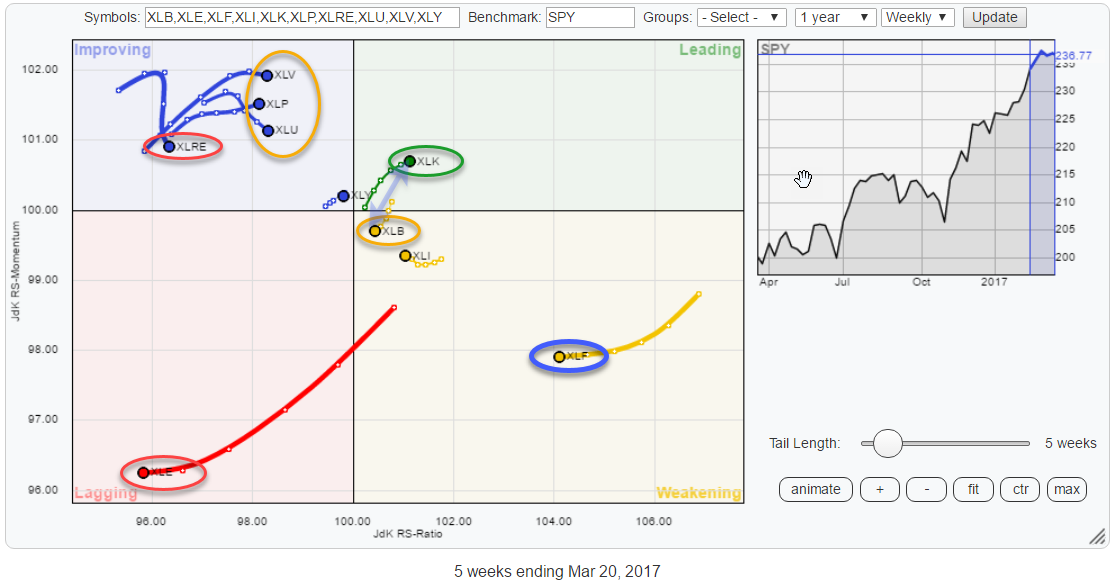 This post looks at the rotation of US sectors again. The Relative Rotation Graph above holds the ETFs that track the performance of US sectors.
This post looks at the rotation of US sectors again. The Relative Rotation Graph above holds the ETFs that track the performance of US sectors.
Pretty much immediately the attention goes out to the Energy sector (XLE) and the Financials sector (XLF) as they stand out because of the length of their tails.
Another combination worth keeping an eye on is the opposite rotation of Technology (XLK) versus Materials (XLB).
Inside the improving quadrant, we find four sectors which are all slowing down their advance on the JdK RS-Momentum scale or already declining, Real-Estate being the most prominent.
Summary
- Renewed weakness for Real-Estate (XLRE)
- Healthcare and Financials back to their primary relative trends?
- Relative Momentum for Financials (XLF) appears to be curling up again
- Relative Momentum for Healthcare (XLV) rolling over back down
- Three breaks (and you're out) for Energy sector (XLE) suggesting more weakness ahead
Real Estate - $SPRE (XLRE)
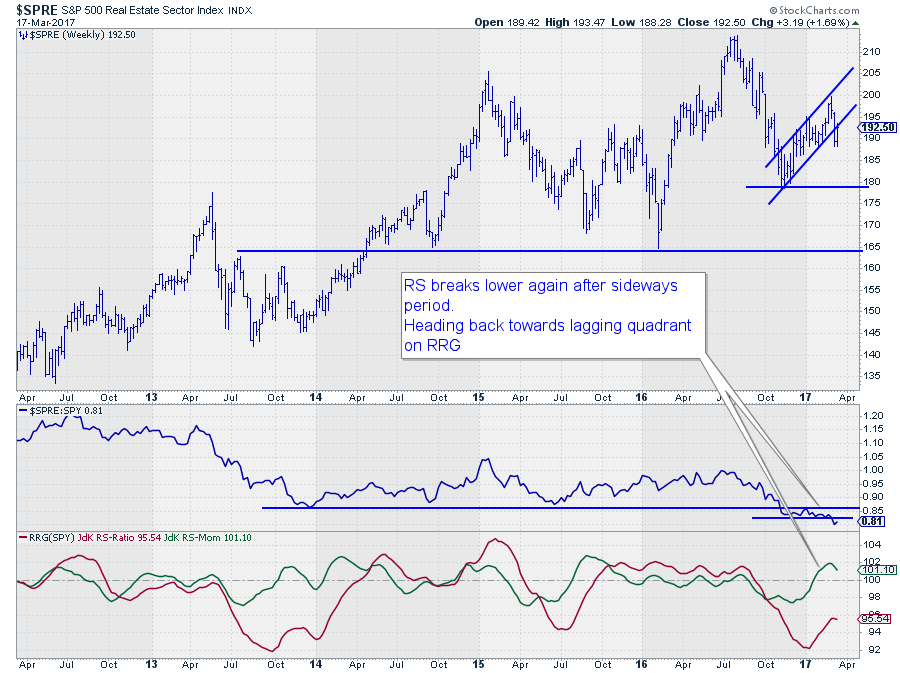 The above chart shows the performance of the S&P 500 Real Estate Sector Index. I had to switch to this chart as the XLRE ETF, that tracks this sector, only has limited history. As the correlation between the ETF and the underlying index is (by default) very high, it does not make a big difference, or no difference at all, for the analysis.
The above chart shows the performance of the S&P 500 Real Estate Sector Index. I had to switch to this chart as the XLRE ETF, that tracks this sector, only has limited history. As the correlation between the ETF and the underlying index is (by default) very high, it does not make a big difference, or no difference at all, for the analysis.
The reason for including the chart in this article is the rotation of this sector on the Relative Rotation Graph.
XLRE is inside the improving quadrant on the RRG and showed a nice run-up, primarily on the RS-Momentum scale since late last year.
We need to bring in a bit more of the rotational history to get a better handle on this rotation. As you can read from the chart above the raw RS-Line started to decline, again, in the middle of 2016. After breaking below horizontal support on the RS chart in October, there was no real follow through, and relative strength started to move sideways.
This flattening of the RS-Line made RS-Momentum go higher and push above 100 and drag XLRE into the improving quadrant. But that improvement of relative momentum has not been enough to pull RS-Ratio significantly higher, and it is still around the lowest levels of RS-Ratio that we have seen over the past five years.
The recent break lower, again, in the raw RS-Line of $SPRE against SPY is taking its toll on the RS-Momentum line which has already started to turn lower again.
This causes XLRE (or $SPRE) to rotate back down again on the RRG indicating that a new down leg in relative strength against SPY is underway.
Financials - XLF
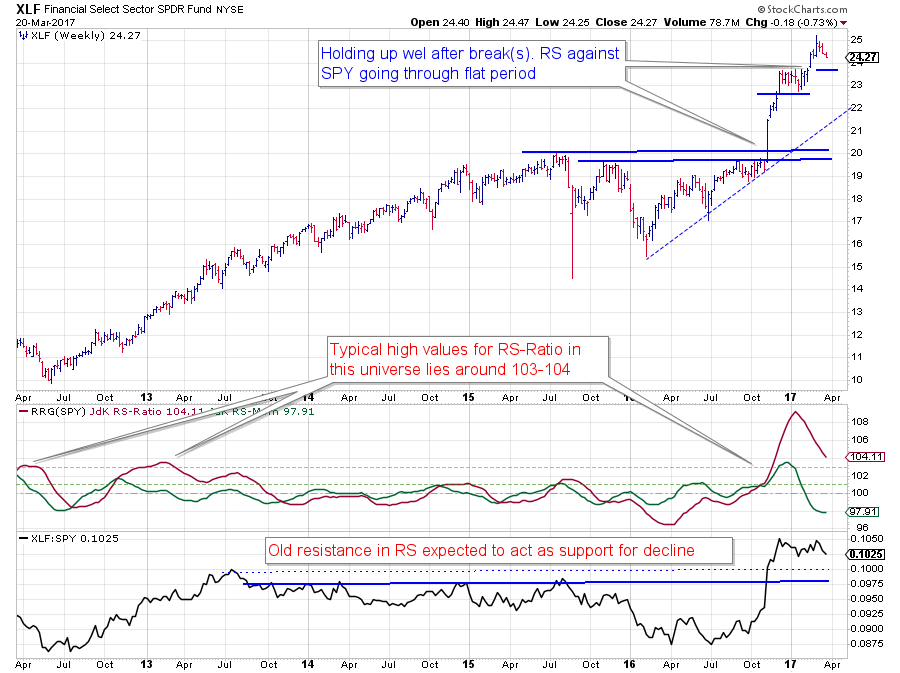 The Financials sector is in the process of making a wide rotation on the Relative Rotation Graph. The push into the leading quadrant started in October of last year when JdK RS-Ratio followed the RS-Momentum line above the 100-level.
The Financials sector is in the process of making a wide rotation on the Relative Rotation Graph. The push into the leading quadrant started in October of last year when JdK RS-Ratio followed the RS-Momentum line above the 100-level.
The acceleration higher in the raw RS-Line and its break above the major horizontal resistance area caused the RS-Ratio line, which is measuring relative trend (up or down) and this trend's strength, to rise to extremely high levels (within the context of this particular universe of US sectors). After the strong rally of RS, the trend stalled and started to move flat which drags the RRG-Lines down.
In these cases where RS-Ratio stretches itself to really high levels very often, a rotation will complete on the right-hand side of the Relative Rotation Graph, marking a pause or a correction within the existing uptrend. This also seems to be happening in this case. We have seen XLF dropping on the RS-Momentum scale while RS-Ratio is still well above the 100-level and now RS-Momentum is starting to level off around and potentially curling back up.
With the RS-Ratio line around 104, there is a very good possibility for XLF to turn back up again and head back towards the leading quadrant and resume its relative uptrend against SPY.
Health Care - XLV
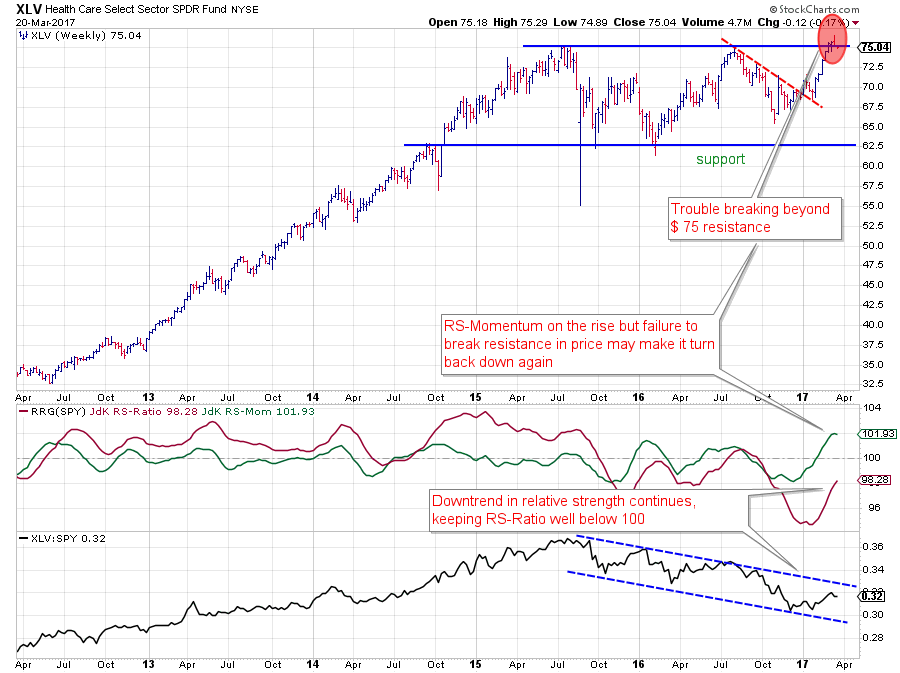 The opposite rotation is visible in the Healthcare sector (XLV). The Relative Strength line of XLV against SPY is in a down trending channel since mid-2015. This translates into an RS-Ratio line that moves, predominantly, below 100.
The opposite rotation is visible in the Healthcare sector (XLV). The Relative Strength line of XLV against SPY is in a down trending channel since mid-2015. This translates into an RS-Ratio line that moves, predominantly, below 100.
After another acceleration lower within the channel in Q4-2016, RS came to rest at the falling support line that marks the lower boundary. The shallow rally off of that support level (but still within the downtrend) pulled the RRG-Lines higher and JdK RS-Momentum even above 100. This interaction of the RRG-Lines positions XLV inside the improving quadrant since early February.
However, just like RS-Momentum seems to be curling up for XLF against SPY, RS-momentum appears to be rolling over for XLV against SPY.
In a previous article here, I mentioned XLV-XLF as a potential trading idea because both were at extreme levels on the RRG chart. The clip below shows the rotation since the week of that previous post.
Given the current signs of RS-Momentum for both sectors starting to roll back up/down, it seems a good moment to pocket a bit of that alpha and watch the rotation of both sectors for a resumption of their primary trends!
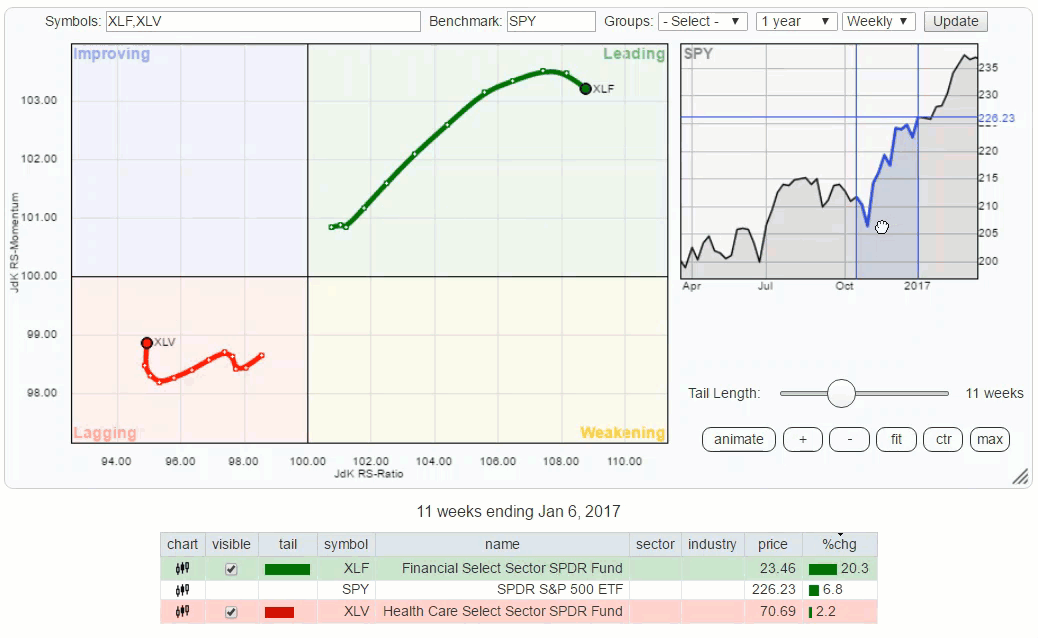
Energy - XLE
The sector that stands out most on the RRG at the moment is Energy (XLE). That long tail powering into the lagging quadrant deserves attention. Especially when you watch the sector rotation for Energy over the past three years (see clip below), you can see that this sector has been moving at the extreme edges of the spectrum almost continuously.
 The current rotation is taking place after a rotation had completed on the right side of the RRG before finally pushing into the lagging quadrant. As XLE is now already the weakest sector in this universe, measured by RS-Ratio, and still pushing deeper into the lagging quadrant, not much strength is expected for Energy in coming weeks.
The current rotation is taking place after a rotation had completed on the right side of the RRG before finally pushing into the lagging quadrant. As XLE is now already the weakest sector in this universe, measured by RS-Ratio, and still pushing deeper into the lagging quadrant, not much strength is expected for Energy in coming weeks.
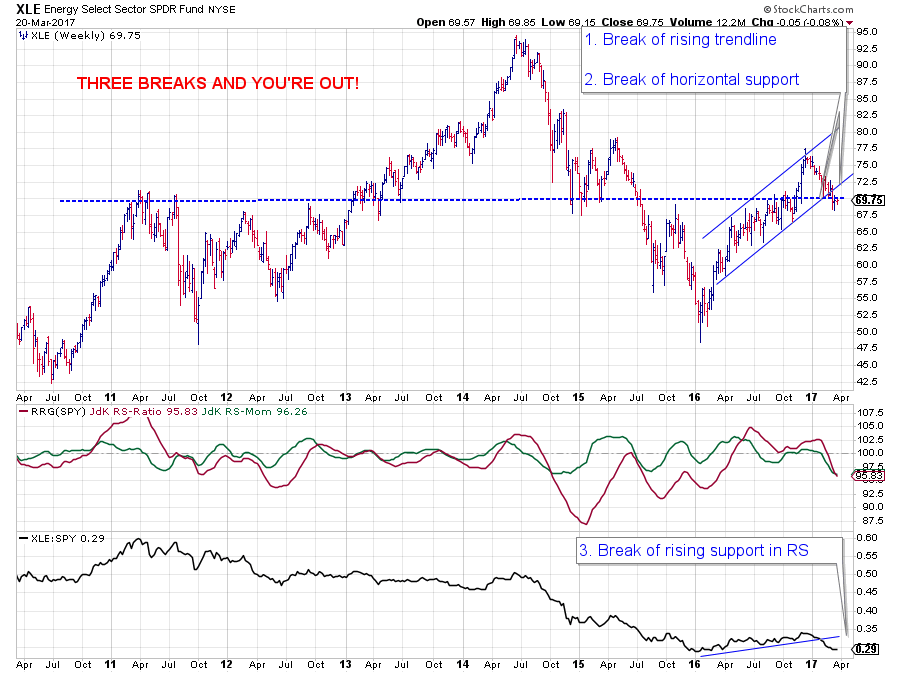 This weakness is also showing up on the price chart in combination with the RRG-Lines.
This weakness is also showing up on the price chart in combination with the RRG-Lines.
Starting at the price graph in the top pane above we can see that XLE is in the process of breaking below the rising support line that marks the uptrend out of the early 2016 low.
Co-incidentally, the level of that rising support line comes in at the same level of the horizontal level near $ 70 which has acted both as support as well as resistance over the past few years.
This combination makes the area around $ 70 a so-called double support level.
Consequently, two support levels get broken below $ 70.
Moving to the relative charts, the RRG-Lines in the middle pane and the raw RS-Line in the bottom pane we see that the rising support line that emerged out of the early 2016 relative low broke a few week ago.
This is the third break for XLE and the combination of all three together cause the RRG-Lines to drop fast and push Energy stocks deep into the lagging quadrant.
Three breaks and you're out .... at least for the coming weeks.
Julius de Kempenaer | RRG Research
RRG, Relative Rotation Graphs, JdK RS-Ratio and JdK RS-Momentum are registered TradeMarks by RRG Research.
If you are posting on S.C.A.N. or participating in a discussion about RRG and you would like me to know about it or get an answer (quicker) please use my handle Julius_RRG so I will receive a notification.
Follow RRG Research on social media:






